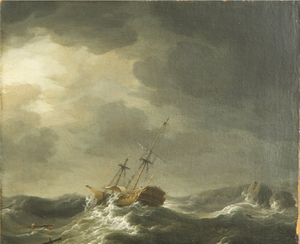
Back HMS Wager (1739) Spanish اچاماس شرطبندی (۱۷۳۹) Persian HMS Wager (1739) French אה"מ וייג'ר (1739) HE HMS Wager (1739) Russian
 Charles Brooking's 1744 painting of HMS Wager in extremis, based on the Bulkeley's published journal
| |
| History | |
|---|---|
| Name | Wager |
| Owner | Hugh Raymond[1] |
| Operator | East India Company |
| Builder | Buxton, Rotherhithe[1] |
| Launched | 12 March 1734[1] |
| Fate | Sold to the Royal Navy in 1739 |
| Name | HMS Wager |
| Cost | £3,912 2s 1½d |
| Acquired | Purchased on 21 November 1739 |
| Commissioned | December 1739 |
| Fate | Wrecked off Chile on 14 May 1741 |
| General characteristics [2] | |
| Class and type | Sixth rate |
| Tons burthen | 551,[1] or 55882⁄94 (bm) |
| Length | 123 ft (37.5 m) (gundeck); 101 ft 4+1⁄8 in (30.9 m) |
| Beam | 32 ft 2+3⁄8 in (9.8 m) |
| Depth of hold | 14 ft 4 in (4.4 m) |
| Sail plan | Ship rig |
| Complement |
|
| Armament | 28 guns |
HMS Wager was a square-rigged sixth-rate Royal Navy ship of 28 guns. It was built as an East Indiaman in about 1734 and made two voyages to India for the East India Company before the Royal Navy purchased her in 1739. It formed part of a squadron under Commodore George Anson and was wrecked on the south coast of Chile on 14 May 1741. The wreck of Wager became famous for the subsequent adventures of the survivors who found themselves marooned on the desolate Wager Island in the middle of a Patagonian winter, and in particular because of the Wager Mutiny that followed.